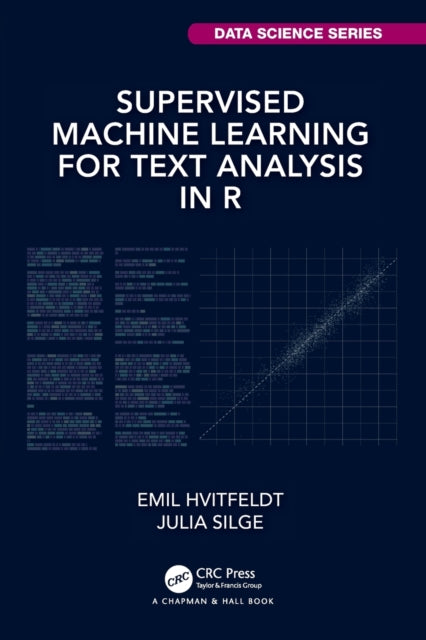Emil Hvitfeldt,Julia Silge
Supervised Machine Learning for Text Analysis in R
Supervised Machine Learning for Text Analysis in R
YOU SAVE £2.50
- Condition: Brand new
- UK Delivery times: Usually arrives within 2 - 3 working days
- UK Shipping: Fee starts at £2.39. Subject to product weight & dimension
Bulk ordering. Want 15 or more copies? Get a personalised quote and bigger discounts. Learn more about bulk orders.
Couldn't load pickup availability
- More about Supervised Machine Learning for Text Analysis in R
Preprocessing steps such as tokenization, stemming, and removing stop words significantly impact predictive models. They help improve the model's accuracy and performance by preparing the text data for analysis. Building end-to-end workflows for predictive modeling using text as features and comparing traditional machine learning methods and deep learning methods for text data are essential steps in developing effective text-based solutions.
\n Format: Paperback / softback
\n Length: 402 pages
\n Publication date: 22 October 2021
\n Publisher: Taylor & Francis Ltd
\n
Preprocessing steps such as tokenization, stemming, and removing stop words play a crucial role in the success of predictive models. These processes are essential in preparing text data for analysis and modeling, as they help to normalize and standardize the data, making it more accessible and useful for machine learning algorithms.
Tokenization involves breaking down text into individual words or phrases, while stemming reduces words to their base or root form. Stop words, such as "the," "a," and "an," are commonly removed as they can contribute little information to the model and can also increase the model's complexity. By performing these preprocessing steps, the model can better understand the context and meaning of the text, leading to improved accuracy and performance.
One of the key benefits of preprocessing is that it can help to reduce the dimensionality of the data, which can improve the speed and efficiency of the model. High-dimensional data can be challenging to train and optimize, as it requires more computational resources and can lead to overfitting. By reducing the dimensionality of the data, the model can focus on the most relevant features and improve its generalization ability.
Another benefit of preprocessing is that it can help to address data imbalance. Text data often contains a significant number of rare or low-frequency words, which can bias the model towards these words and lead to poor performance on unseen data. Preprocessing steps such as tokenization and stemming can help to normalize the distribution of words, reducing the impact of rare or low-frequency words on the model's predictions.
In addition to these benefits, preprocessing can also be used to enhance the interpretability of the model. By removing stop words and other irrelevant features, the model can focus on the most important words and phrases that contribute to its predictions. This can help to make the model more transparent and easier to understand, which can be valuable for decision-making and interpretation.
There are several different preprocessing techniques available, each with its own advantages and disadvantages. Some common techniques include tokenization, stemming, stop word removal, text cleaning, and feature extraction. Each technique has its own specific application and can be used in combination to achieve the desired results.
For example, tokenization can be used to split large text files into smaller, more manageable chunks, while stemming can be used to reduce the number of different forms of a word. Stop word removal can be used to remove common words that do not contribute to the model's predictions, while text cleaning can be used to remove punctuation, symbols, and other non-textual elements. Feature extraction can be used to extract relevant features from the text, such as keywords, phrases, and sentiment analysis.
In conclusion, preprocessing steps such as tokenization, stemming, and removing stop words are essential for predictive modeling. These processes help to normalize and standardize the data, reduce the dimensionality of the data, address data imbalance, enhance the interpretability of the model, and can be used in combination to achieve the desired results. By performing these preprocessing steps, organizations can improve the accuracy and performance of their predictive models and make more informed decisions based on their text data.
\n Weight: 744g\n
Dimension: 234 x 156 (mm)\n
ISBN-13: 9780367554194\n \n
This item can be found in:
UK and International shipping information
UK and International shipping information
UK Delivery and returns information:
- Delivery within 2 - 3 days when ordering in the UK.
- Shipping fee for UK customers from £2.39. Fully tracked shipping service available.
- Returns policy: Return within 30 days of receipt for full refund.
International deliveries:
Shulph Ink now ships to Australia, Belgium, Canada, France, Germany, Ireland, Italy, India, Luxembourg Saudi Arabia, Singapore, Spain, Netherlands, New Zealand, United Arab Emirates, United States of America.
- Delivery times: within 5 - 10 days for international orders.
- Shipping fee: charges vary for overseas orders. Only tracked services are available for most international orders. Some countries have untracked shipping options.
- Customs charges: If ordering to addresses outside the United Kingdom, you may or may not incur additional customs and duties fees during local delivery.


